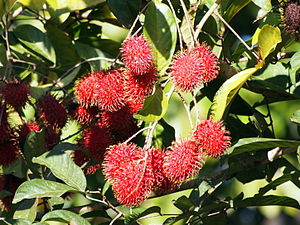Note: This is a project under development. The articles on this wiki are just being initiated and broadly incomplete. You can Help creating new pages.
Difference between revisions of "Nephelium lappaceum - Rambutan"
m (Prabhakar moved page Rambutan to Rambutan (Nephelium lappaceum)) |
m (Prabhakar moved page Rambutan (Nephelium lappaceum) to Nephelium lappaceum - Rambutan) |
(No difference)
| |
Revision as of 10:38, 23 April 2018
The rambutan (/ræmˈbuːtən/; taxonomic name: Nephelium lappaceum) is a medium-sized tropical tree in the family Sapindaceae. The name also refers to the edible fruit produced by this tree. The rambutan is native to the Malay-Indonesian region,[1] and other regions of tropical Southeast Asia.[2] It is closely related to several other edible tropical fruits including the lychee, longan, and mamoncillo.[1][2]
Contents
Description
It is an evergreen tree growing to a height of 12–20 m. The leaves are alternate, 10–30 cm long, pinnate, with three to 11 leaflets, each leaflet 5–15 cm wide and 3–10 cm broad, with an entire margin. The flowers are small, 2.5–5 mm, apetalous, discoidal, and borne in erect terminal panicles 15–30 cm wide.[2]
Rambutan trees can be male (producing only staminate flowers and, hence, produce no fruit), female (producing flowers that are only functionally female), or hermaphroditic (producing flowers that are female with a small percentage of male flowers).
The fruit is a round to oval single-seeded berry, 3–6 cm (rarely to 8 cm) long and 3–4 cm broad, borne in a loose pendant cluster of 10–20 together. The leathery skin is reddish (rarely orange or yellow), and covered with fleshy pliable spines, hence the name, which means 'hairs'. The fruit flesh, which is actually the aril, is translucent, whitish or very pale pink, with a sweet, mildly acidic flavor very reminiscent of grapes.
The single seed is glossy brown, 1–1.3 cm, with a white basal scar. Soft and containing equal portions of saturated and unsaturated fats, the seeds may be cooked and eaten. The peeled fruits can be eaten raw, or cooked and eaten: first, the grape-like fleshy aril, then the nutty seed, with no waste.
Uses
- Rambutan helps to boost energy.
- It helps in generation Of White And Red Blood Cells.
- It helps to remove wastes from the kidney.[3]
